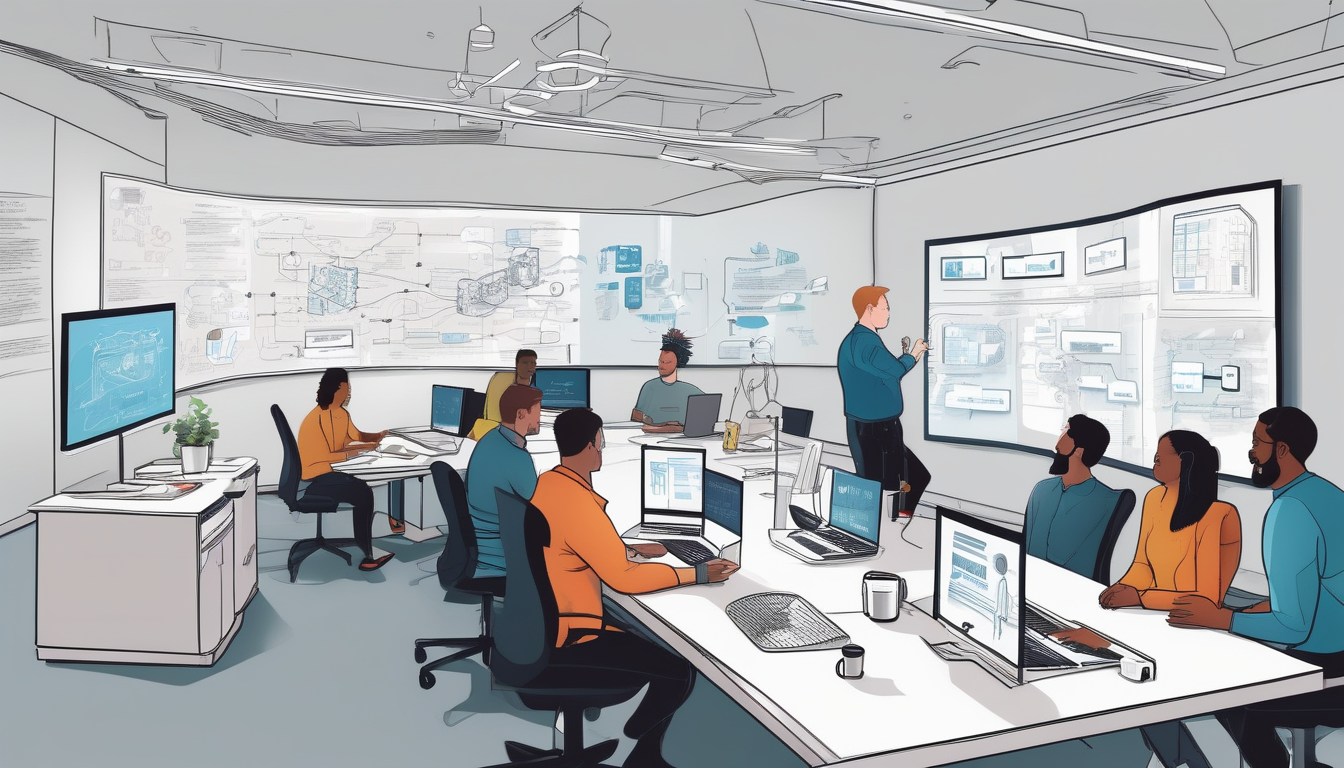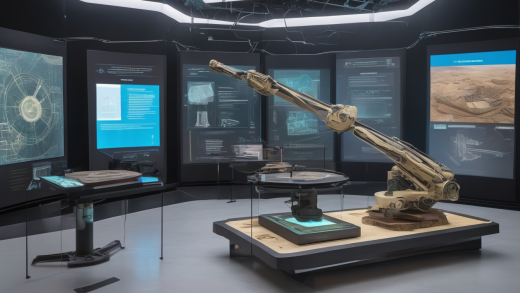Integrating AI technologies into IT departments can feel like trying to fit a square peg in a round hole. It’s not just about the tech; it’s about the people behind it. Many organizations face significant resistance from their IT teams when it comes to AI adoption. This resistance often stems from a mix of fear, uncertainty, and a lack of understanding. Imagine being asked to use a tool you’ve never seen before, one that could potentially replace your job! That’s the reality many IT professionals face, and it’s crucial to recognize these sentiments to pave the way for a smoother integration process.
To effectively address this resistance, organizations need to take a proactive approach. First, they must identify the root causes of these fears. Is it the fear of job loss? Concerns about reliability? Or perhaps a general skepticism towards new technologies? By understanding these challenges, companies can tailor their strategies to not only alleviate concerns but also foster a sense of collaboration between IT and AI teams.
Building a culture of collaboration is vital. This means creating an environment where open communication is encouraged, and where both teams can work towards shared goals. When IT professionals feel included in the AI journey, their resistance diminishes. It’s like inviting someone into a conversation rather than talking at them; they are more likely to engage when they feel heard and valued.
Moreover, providing targeted training and educational resources can be a game changer. Workshops, seminars, and continuous learning opportunities can demystify AI for IT staff, transforming fear into empowerment. Imagine turning skeptics into advocates simply by equipping them with knowledge! By showcasing success stories and real-world applications of AI, organizations can illustrate the tangible benefits of these technologies, making the transition less daunting.
In conclusion, overcoming IT resistance to AI integration is not just about technology—it’s about people. By fostering communication, providing education, and involving IT teams in the strategy development process, organizations can create a more accepting environment for AI technologies. Embracing this change can lead to innovative solutions and a more efficient IT landscape.

Understanding IT Resistance
When it comes to integrating AI technologies within IT departments, resistance is often a common hurdle. But why does this resistance exist? One major factor is the fear of job displacement. IT professionals may worry that AI will render their roles obsolete, leading to anxiety about their future in the workplace. This fear can create a defensive mindset, making them less open to new technologies.
Another reason for this resistance is a lack of understanding about what AI truly entails. Many IT staff members may have misconceptions about AI, viewing it as a complex, foreign technology rather than a tool that can enhance their work. This lack of familiarity breeds skepticism, as they might not see the potential benefits that AI can bring to their daily tasks.
Additionally, concerns about reliability play a significant role in IT resistance. IT professionals are often tasked with ensuring the stability and security of their systems. Introducing AI can raise questions about how these technologies will impact existing workflows and whether they can be trusted to perform critical functions. It’s crucial to recognize these underlying issues to develop effective strategies for overcoming resistance.
To tackle these challenges, organizations should consider implementing a range of strategies. For instance, creating a culture of open communication can help bridge the gap between AI and IT teams. By fostering an environment where concerns can be voiced and addressed, organizations can alleviate fears and build a foundation of trust. Moreover, providing training and educational resources about AI technologies can empower IT staff, turning their skepticism into enthusiasm.
In summary, understanding the roots of IT resistance is essential for successful AI integration. By addressing fears, enhancing knowledge, and ensuring reliable communication, organizations can pave the way for a smoother transition into the AI era.

Building a Collaborative Culture
Creating a collaborative culture between IT and AI teams is like planting a garden; it requires time, care, and the right conditions to flourish. When both teams work together, they can cultivate an environment that encourages innovation and reduces resistance to AI integration. Think about it: when communication flows freely, and everyone is on the same page, the chances of success skyrocket. So, how can organizations foster this kind of synergy?
First off, it’s essential to establish open lines of communication. Regular meetings, brainstorming sessions, and even casual check-ins can make a world of difference. These interactions not only help in sharing ideas but also build relationships. When team members feel comfortable discussing their thoughts and concerns, it paves the way for a more unified approach to AI projects.
Moreover, aligning the goals of both teams is crucial. By setting shared objectives, everyone knows what they are working towards, which can significantly diminish feelings of competition or fear. For instance, if the IT team understands that the AI implementation is designed to enhance their workflow rather than replace them, their resistance will naturally decrease. This alignment can be achieved through:
- Joint planning sessions
- Collaborative project timelines
- Shared success metrics
Another pivotal aspect is recognizing and celebrating achievements. When teams reach milestones together, acknowledging those successes can boost morale and motivate further collaboration. A simple shout-out in a team meeting or a dedicated communication channel for celebrating wins can go a long way in reinforcing a sense of community.
In summary, building a collaborative culture is not just about reducing resistance; it’s about creating a thriving ecosystem where innovation can take root. By fostering open communication, aligning goals, and celebrating successes, organizations can ensure that their IT and AI teams work hand-in-hand, paving the way for a successful AI integration journey.
Training and Education
When it comes to integrating AI into IT departments, one of the most effective ways to combat resistance is through comprehensive . Many IT professionals harbor fears and misconceptions about AI, often viewing it as a potential threat to their jobs. However, by providing them with the right tools and knowledge, organizations can transform these fears into excitement and curiosity. Imagine walking into a room filled with IT staff, their faces lighting up as they grasp how AI can enhance their current workflows rather than replace them. This shift in perspective is crucial for successful integration.
To achieve this, companies should implement a variety of educational initiatives. For instance, offering workshops and seminars can create a dynamic learning environment where IT professionals can engage directly with AI experts. Such events not only allow for hands-on experience but also foster a sense of community among staff. They can ask questions, share their thoughts, and collaborate on solutions that are tailored to their specific needs. This interaction is vital in breaking down the walls of resistance and building a foundation of trust.
Moreover, establishing continuous learning opportunities is essential in keeping IT teams updated on the latest AI advancements. A well-structured continuous learning program can include:
- Online courses covering various AI technologies
- Regular webinars featuring industry leaders
- Access to resources like articles, tutorials, and case studies
By adopting a proactive approach to education, organizations not only empower their IT staff but also cultivate a culture of adaptability and innovation. In the fast-paced world of technology, staying ahead means embracing change, and education is the key to unlocking that potential. Ultimately, when IT professionals feel equipped and informed, they are much more likely to embrace AI as a valuable ally in their work, paving the way for a smoother integration process.
Workshops and Seminars
Organizing workshops and seminars is a fantastic way to bridge the gap between IT professionals and AI technologies. These events serve as a platform for hands-on learning, allowing participants to dive deeper into the world of AI. Imagine walking into a room filled with eager minds, all ready to explore the endless possibilities that AI can bring to their daily work. It’s not just about presenting information; it’s about creating an engaging environment where questions are welcomed, ideas are exchanged, and real connections are made.
During these sessions, IT staff can interact directly with AI experts, gaining insights that textbooks simply can’t provide. The atmosphere is often electric, as participants engage in discussions that challenge their preconceived notions about AI. For instance, a workshop might include a live demonstration of an AI tool that automates mundane tasks, showcasing how it can enhance productivity rather than threaten job security.
One effective format for these events is to incorporate
- Interactive demonstrations
- Case studies of successful AI implementations
- Q&A sessions with industry leaders
This approach not only keeps the audience engaged but also allows for immediate feedback and clarification of doubts. By the end of the workshop, participants often leave with a renewed sense of purpose and excitement about the potential of AI.
Furthermore, these workshops can be tailored to address specific concerns or interests within the organization. For example, if a particular team is worried about how AI will impact their workflow, a focused seminar can be organized to explore those specific challenges. This level of customization shows that the organization values its employees’ input and is committed to providing the necessary resources for them to thrive in an AI-enhanced environment.
In conclusion, workshops and seminars are not just educational tools; they are vital instruments for fostering a culture of collaboration and openness. By investing in these opportunities, organizations can demystify AI, reduce resistance, and pave the way for a smoother integration process.
Continuous Learning Opportunities
In the rapidly evolving world of technology, continuous learning is not just an option; it’s a necessity. For IT professionals, staying updated on the latest advancements in artificial intelligence (AI) can significantly enhance their ability to integrate these technologies effectively. Organizations should prioritize establishing comprehensive learning programs that cater to the diverse needs of their IT staff. This commitment to education not only empowers employees but also fosters a culture of innovation and adaptability.
One effective way to implement continuous learning is through a structured program that includes online courses, webinars, and certification opportunities. These resources can be tailored to different skill levels, ensuring that everyone, from beginners to advanced users, finds value in the training provided. For instance, a beginner’s course might cover the fundamentals of AI, while advanced sessions could delve into machine learning algorithms or data analytics.
Moreover, organizations can facilitate peer-to-peer learning through mentorship programs. Pairing less experienced employees with seasoned professionals can create a dynamic learning environment where knowledge is shared and practical skills are honed. This not only builds confidence among IT staff but also strengthens team cohesion as they work together towards common goals.
To keep the learning momentum going, companies should also encourage participation in industry conferences and workshops. These events are excellent opportunities for IT professionals to network with peers, learn from industry leaders, and gain insights into the latest trends and technologies. By investing in their employees’ growth, organizations demonstrate a commitment to their professional development, which can significantly reduce resistance to AI integration.
In summary, establishing continuous learning opportunities is crucial for empowering IT staff to embrace AI technologies. By providing access to relevant resources, fostering mentorship, and encouraging participation in industry events, organizations can cultivate a workforce that is not only knowledgeable but also enthusiastic about the potential of AI.
Involving IT in AI Strategy Development
When it comes to integrating AI technologies into an organization, one of the most effective strategies is to involve the IT department right from the start. This inclusion not only fosters a sense of ownership among IT professionals but also ensures that their expertise is leveraged in crafting realistic and achievable AI strategies. Think of it like assembling a puzzle; every piece, including the IT team’s insights, is crucial for completing the picture.
By engaging IT in the early stages of AI strategy development, organizations can benefit in several ways:
- Enhanced Collaboration: Involving IT creates a collaborative atmosphere where both AI and IT teams can share ideas, challenges, and solutions, leading to a more comprehensive strategy.
- Realistic Planning: IT professionals have a deep understanding of existing systems and processes, allowing them to provide valuable input on how AI can be integrated without causing disruptions.
- Increased Buy-In: When IT feels included in the decision-making process, they are more likely to support and champion AI initiatives, reducing resistance.
Moreover, this collaborative approach can lead to innovative solutions that might not have been considered if IT was left out of the conversation. For instance, during strategy meetings, IT can highlight potential challenges, such as data security concerns or integration issues, that need to be addressed to ensure a smooth implementation.
Ultimately, involving the IT department in AI strategy development is not just a best practice; it’s a game changer. It transforms the integration process from a top-down directive into a cooperative effort, paving the way for a more successful and sustainable AI adoption. By valuing the input of IT, organizations can create a roadmap that not only meets technological goals but also aligns with the overall business objectives.

Addressing Concerns through Communication
When it comes to integrating AI into IT departments, one of the most effective strategies is to foster open communication. This means creating an environment where IT staff feel comfortable voicing their concerns, asking questions, and sharing their thoughts. It’s not just about talking; it’s about listening, too. Regular updates and discussions can significantly mitigate fears surrounding AI integration. Imagine a workplace where everyone is on the same page, and misunderstandings are cleared up before they escalate. That’s the kind of synergy we want to achieve!
To truly address concerns, organizations should consider implementing feedback mechanisms. These can take many forms, such as anonymous surveys, suggestion boxes, or regular check-in meetings. By allowing IT staff to voice their opinions, organizations can not only identify lingering fears but also gain valuable insights into how to make the integration process smoother. This participatory approach fosters a sense of ownership among the team, encouraging them to embrace AI initiatives rather than resist them.
Moreover, showcasing success stories can be a game-changer. Highlighting examples of successful AI integration—whether within the organization or from industry peers—can inspire confidence among IT staff. When they see that AI has positively impacted their colleagues and improved operations, it becomes easier for them to envision similar outcomes in their own work. This is where storytelling becomes a powerful tool. By sharing real-life examples, you not only illustrate the potential benefits of AI but also humanize the technology, making it more relatable and less intimidating.
In conclusion, addressing concerns through effective communication is essential for a smooth AI integration. By creating a culture of openness, implementing feedback mechanisms, and showcasing success stories, organizations can build trust and encourage a more positive attitude toward AI technologies. Remember, it’s not just about technology—it’s about people, and engaging them is key to success.
Feedback Mechanisms
In the fast-paced world of technology, play a pivotal role in bridging the gap between IT departments and AI integration efforts. Think of feedback as the compass guiding your team through uncharted waters. Without it, you may find yourself lost, unsure of how to navigate the challenges that arise during the integration process. By implementing structured feedback channels, organizations can create an environment where IT staff feel empowered to express their concerns and suggestions openly.
One effective approach is to establish regular feedback sessions, where IT professionals can voice their thoughts in a safe space. These sessions can take various forms, such as:
- Monthly roundtable discussions
- Anonymous surveys to gather honest opinions
- One-on-one meetings with team leaders
By utilizing these methods, organizations can foster a culture of transparency and collaboration. When IT staff see that their input genuinely influences AI strategies, they are more likely to engage positively with the integration process. Moreover, this participatory approach not only enhances morale but also cultivates a sense of ownership among team members.
Additionally, showcasing the outcomes of feedback can further motivate IT staff. For instance, if a suggestion leads to a successful AI tool implementation, sharing that success story can inspire others to contribute their ideas. It’s like planting seeds in a garden; with the right nurturing, those seeds can blossom into innovative solutions that benefit everyone.
Ultimately, effective feedback mechanisms are about creating a dialogue. By listening to the voices of IT professionals, organizations can address concerns proactively, paving the way for smoother AI integration. Remember, fostering a culture of open communication not only alleviates fears but also strengthens the entire team’s commitment to embracing AI as a valuable ally in their technological journey.
Showcasing Success Stories
One of the most effective ways to overcome resistance to AI integration within IT departments is by . When IT professionals see real-world examples of AI effectively enhancing business processes, their skepticism can quickly turn into enthusiasm. It’s like seeing a friend transform their life with a new fitness routine; the results speak volumes and inspire others to join in.
For instance, consider a company that implemented AI-driven analytics to streamline their data processing. Initially, the IT team was hesitant, fearing that AI would complicate their workflows. However, after the successful launch of the project, the team saw a 30% reduction in processing time and a significant increase in data accuracy. This tangible success not only boosted morale but also encouraged other departments to explore AI solutions.
Moreover, sharing these success stories can be done through various channels:
- Internal Newsletters: Regular updates featuring success stories can keep the momentum going and maintain interest in AI initiatives.
- Team Meetings: Highlighting achievements during meetings fosters a sense of community and shared purpose.
- Webinars: Hosting sessions where teams discuss their experiences can provide valuable insights and inspire collaboration.
Additionally, creating a success story repository can serve as a powerful resource. This repository can include:
| Company | AI Solution | Results |
|---|---|---|
| Company A | Predictive Maintenance | Reduced downtime by 40% |
| Company B | Customer Support Chatbots | Increased customer satisfaction by 25% |
By illustrating the positive impacts of AI through these success stories, organizations can effectively dismantle the barriers of resistance. Ultimately, when IT teams witness the benefits firsthand, they are more likely to embrace AI as a partner in their journey towards innovation.
Frequently Asked Questions
- What is IT resistance to AI integration?
IT resistance to AI integration refers to the reluctance or opposition from IT departments when adopting artificial intelligence technologies. This resistance often arises from fears of job displacement, a lack of understanding of AI, or concerns about its reliability and effectiveness.
- How can organizations build a collaborative culture for AI integration?
Organizations can foster a collaborative culture by encouraging open communication between IT and AI teams. Setting shared goals and promoting teamwork can significantly reduce resistance and create a more unified approach to integrating AI technologies.
- What role does training play in overcoming IT resistance?
Training is crucial in overcoming IT resistance as it empowers staff with knowledge about AI technologies. By providing educational resources and hands-on workshops, organizations can alleviate fears and misconceptions, helping IT personnel view AI as a valuable tool rather than a threat.
- Why is it important to involve IT in AI strategy development?
Involving IT teams in the planning and strategy development phases of AI projects is essential because their insights and expertise can lead to more realistic and effective integration plans. This inclusion enhances their buy-in and encourages a positive attitude toward AI initiatives.
- How can communication help address concerns related to AI integration?
Open communication is vital for addressing concerns about AI integration. Regular updates and discussions help to mitigate fears, build trust, and ensure that IT staff are informed about the benefits and progress of AI technologies within the organization.
- What are feedback mechanisms, and why are they important?
Feedback mechanisms allow IT staff to voice their concerns and suggestions regarding AI integration. This participatory approach fosters a sense of ownership and encourages a more positive attitude toward AI initiatives, ultimately leading to a smoother integration process.
- How can showcasing success stories benefit AI integration?
Highlighting successful AI integration stories, whether from within the organization or industry peers, can inspire confidence among IT staff. Demonstrating tangible benefits helps illustrate the potential of AI and its positive impact on the IT landscape, reinforcing its value.


